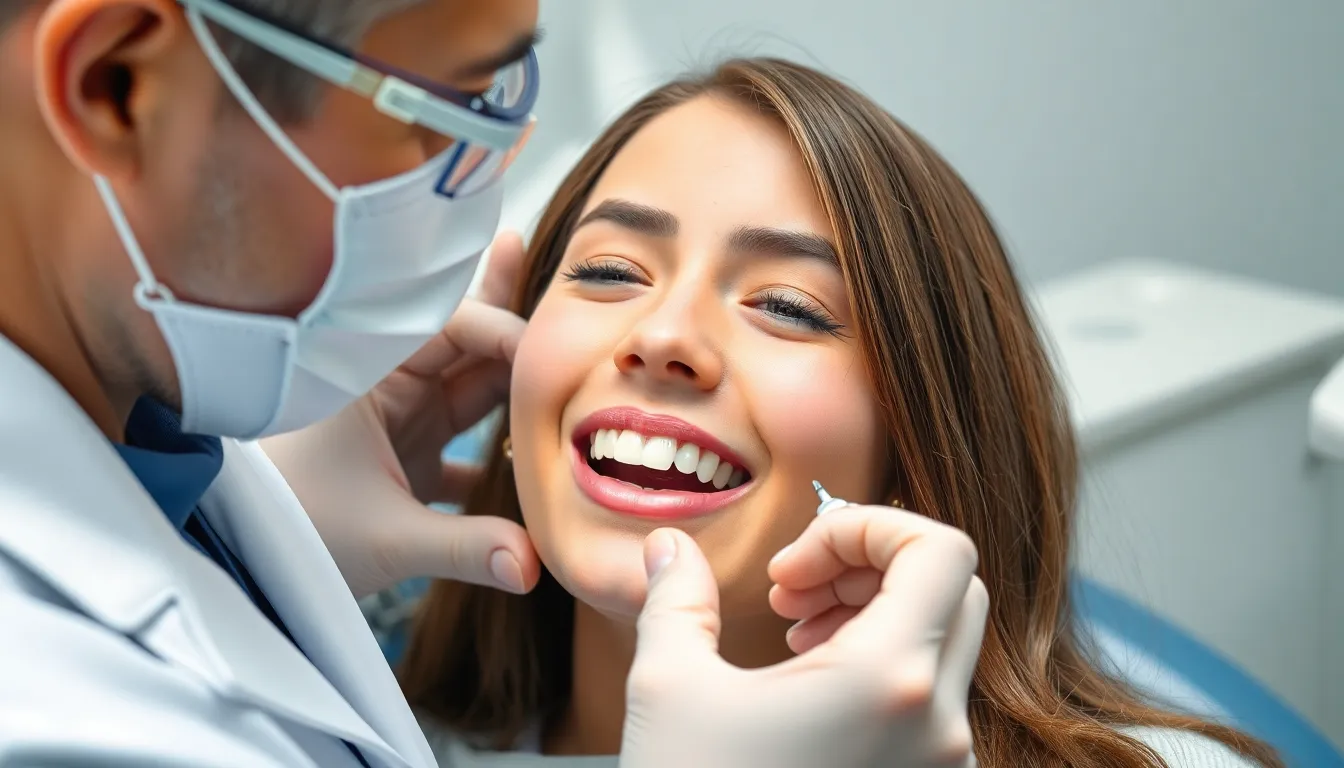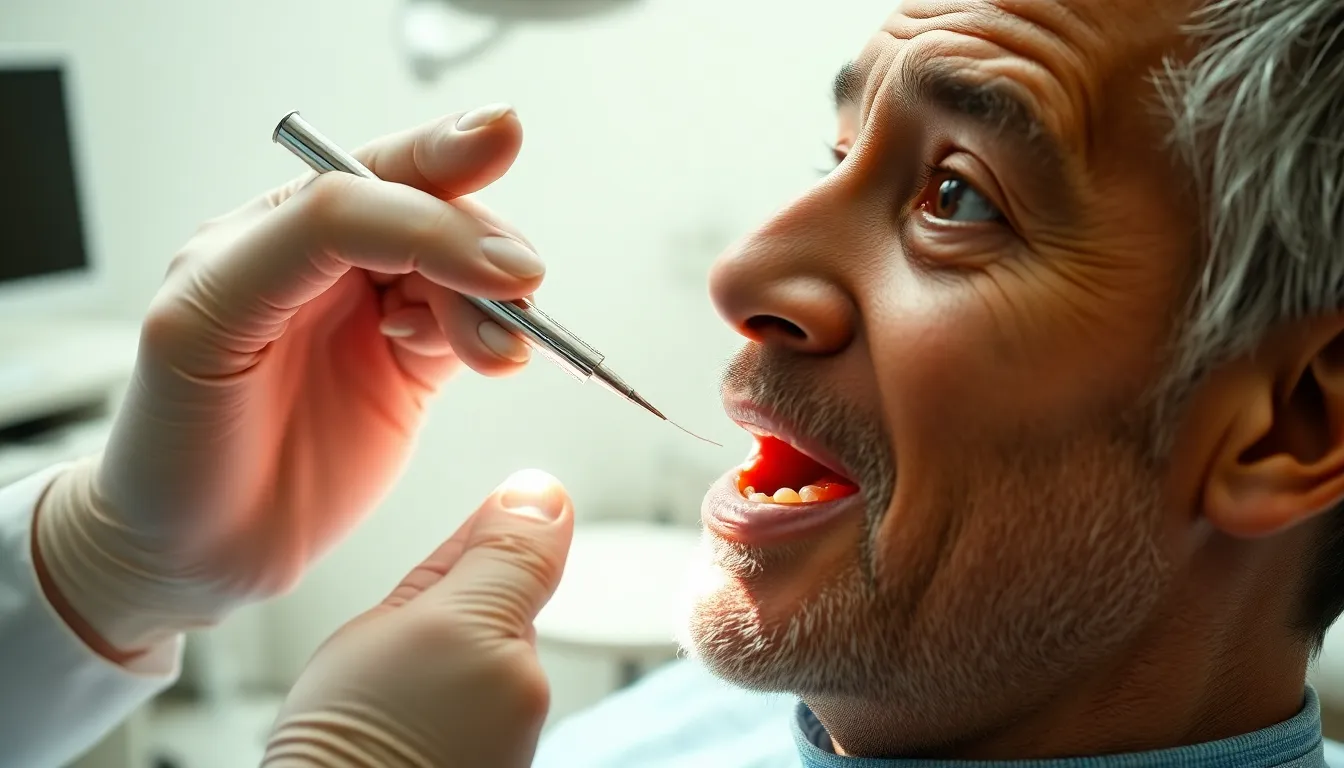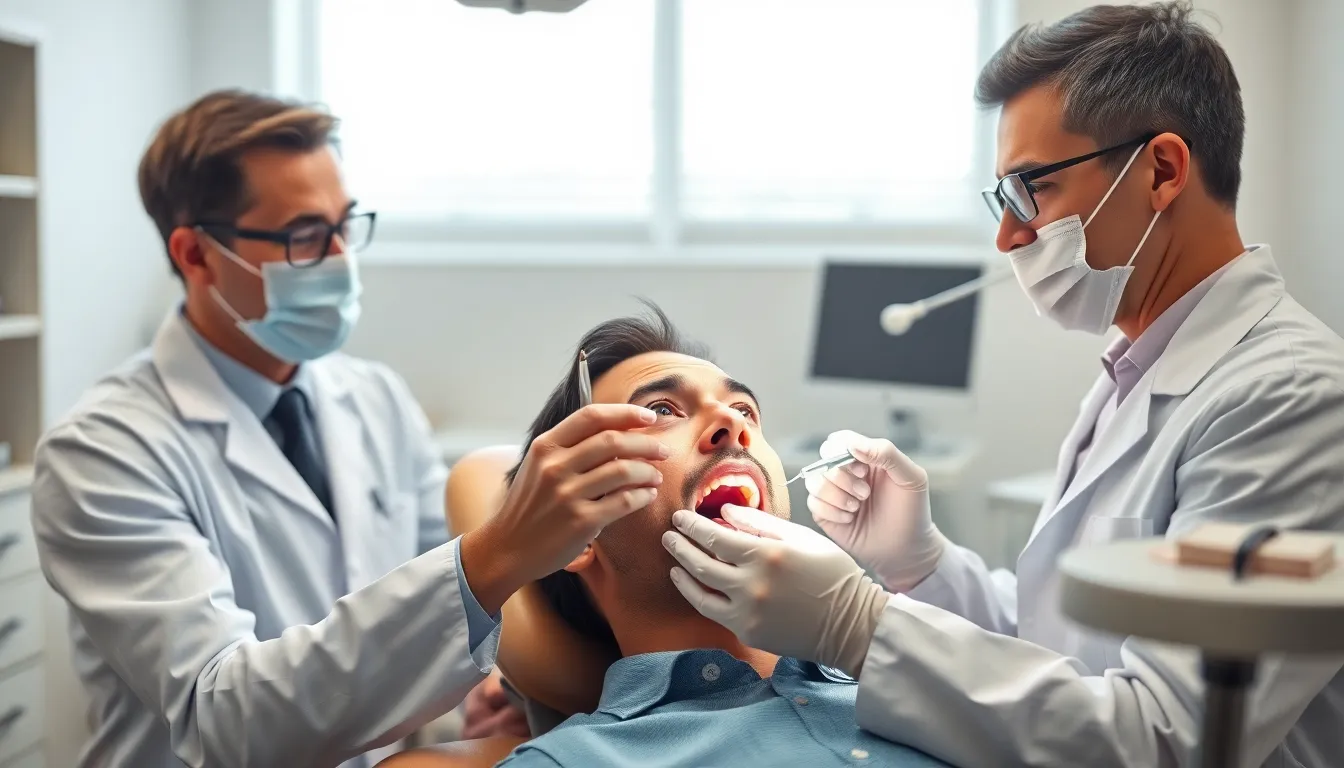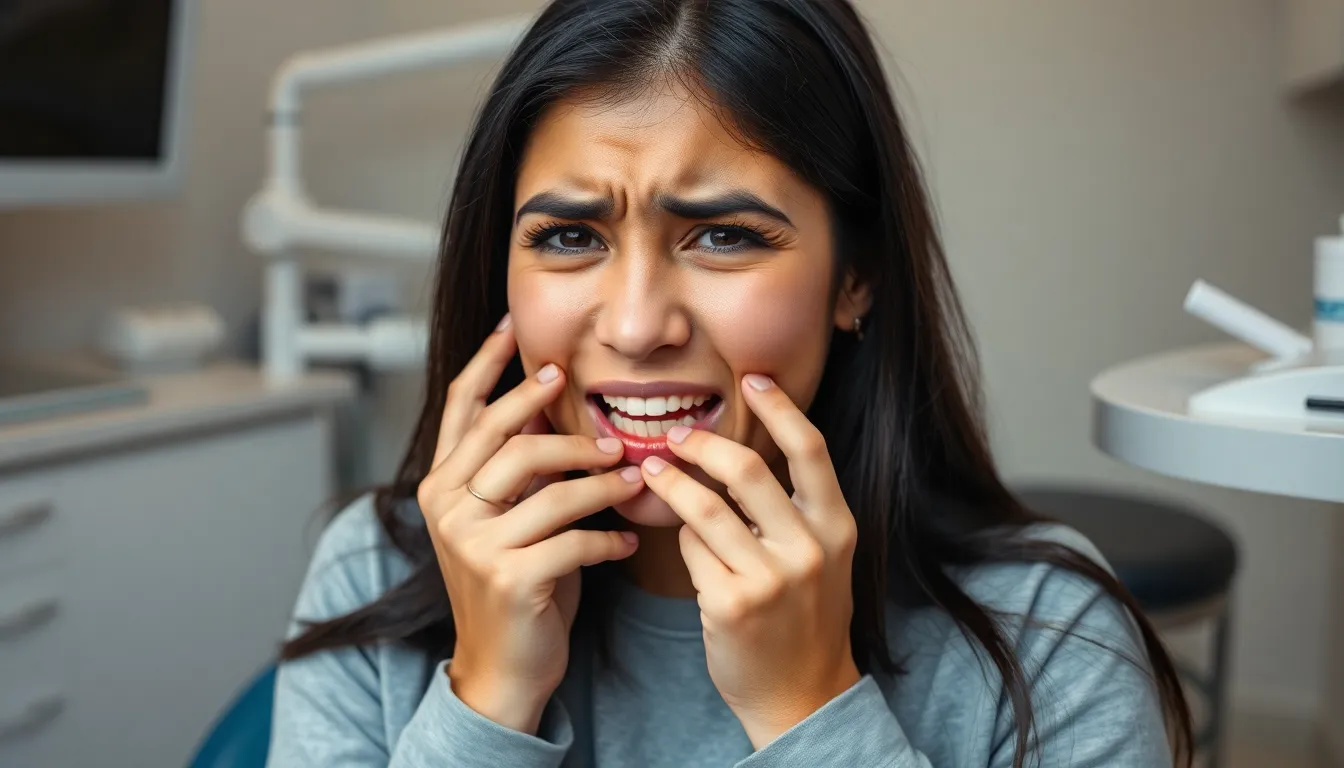Wondering what an overbite looks like? This common dental condition affects millions of people worldwide, yet many aren’t sure if their smile falls into this category. An overbite occurs when your upper front teeth overlap your lower front teeth vertically by more than the normal 2-3 millimeters.
When you look in the mirror, you might notice your upper teeth extending too far over your lower teeth when you bite down. This can range from barely noticeable to more pronounced cases that affect both your appearance and oral function. Understanding what an overbite looks like is the first step toward addressing any concerns you might have about your dental alignment.
What Is an Overbite?
An overbite represents a dental alignment condition where your upper front teeth overlap the lower teeth vertically beyond the normal 2-3 millimeters. Dental professionals classify overbites as a type of malocclusion or improper bite alignment. Your jaw structure plays a important role in determining whether you’ll develop an overbite, as genetics often influence jaw development and tooth positioning.
Dr. Todd B. Harris explains, “Many patients come to my office concerned about their overbites without fully understanding what they’re dealing with. I remember Sarah, a 32-year-old patient who always covered her mouth when smiling in photos. She was surprised to learn her ‘crooked smile’ was actually a moderate overbite that could be addressed with proper treatment.”
Overbites differ from other dental alignment issues like underbites or crossbites. The distinguishing feature centers on the vertical overlap of teeth rather than horizontal misalignment. Dental statistics indicate overbites affect approximately 70% of children in the United States, making them one of the most common orthodontic conditions.
Your overbite severity determines potential complications and treatment approaches. Mild overbites typically present few functional problems, while severe cases can lead to speech difficulties, increased risk of dental trauma, and temporomandibular joint (TMJ) disorders. Functional impacts often accompany aesthetic concerns, particularly with pronounced overbites.
Common Characteristics of an Overbite
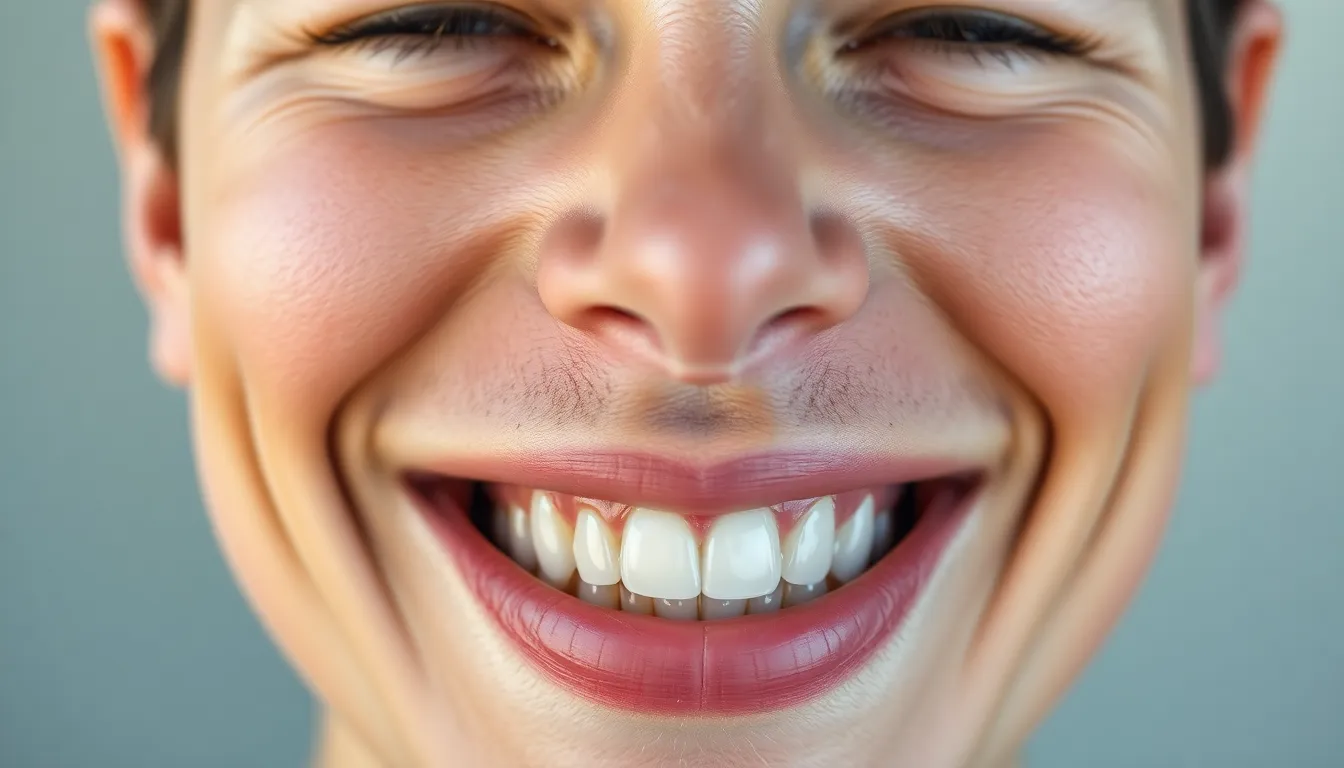
An overbite creates a distinctive dental appearance where your upper front teeth excessively overlap your lower teeth. Normal dental alignment includes a slight vertical overlap of about 2-4 mm or approximately 30% coverage of the lower teeth by the upper teeth.
Visual Signs of a Vertical Overbite
Vertical overbites show a important downward overlap where your upper teeth extend too far over your lower teeth. You’ll notice the lower teeth are partially or almost completely hidden behind the upper teeth when your mouth is closed. This alignment often creates a “closed bite” appearance that affects how your jaws meet when biting down. Many patients experience uncomfortable symptoms with untreated vertical overbites, including jaw pain, accelerated tooth erosion, and gum problems. Dr. Harris recently treated a patient who complained of chronic headaches for years before discovering her deep vertical overbite was the root cause of her discomfort.
How a Horizontal Overbite Appears
Horizontal overbites, also known as overjets, feature upper teeth that protrude forward beyond the lower teeth. This configuration creates the appearance commonly referred to as “buck teeth” where your front teeth jut noticeably outward. You can easily spot a horizontal overbite by looking at someone’s profile, as the upper teeth stick out prominently ahead of the lower teeth. Horizontal overbites sometimes occur with a visible space between upper and lower teeth when the mouth is closed, creating what dentists call an “open bite” condition. Unlike vertical overbites that overlap downward, these overbites project forward and can make lips appear fuller or create difficulty closing the mouth completely.
Different Severity Levels of Overbites
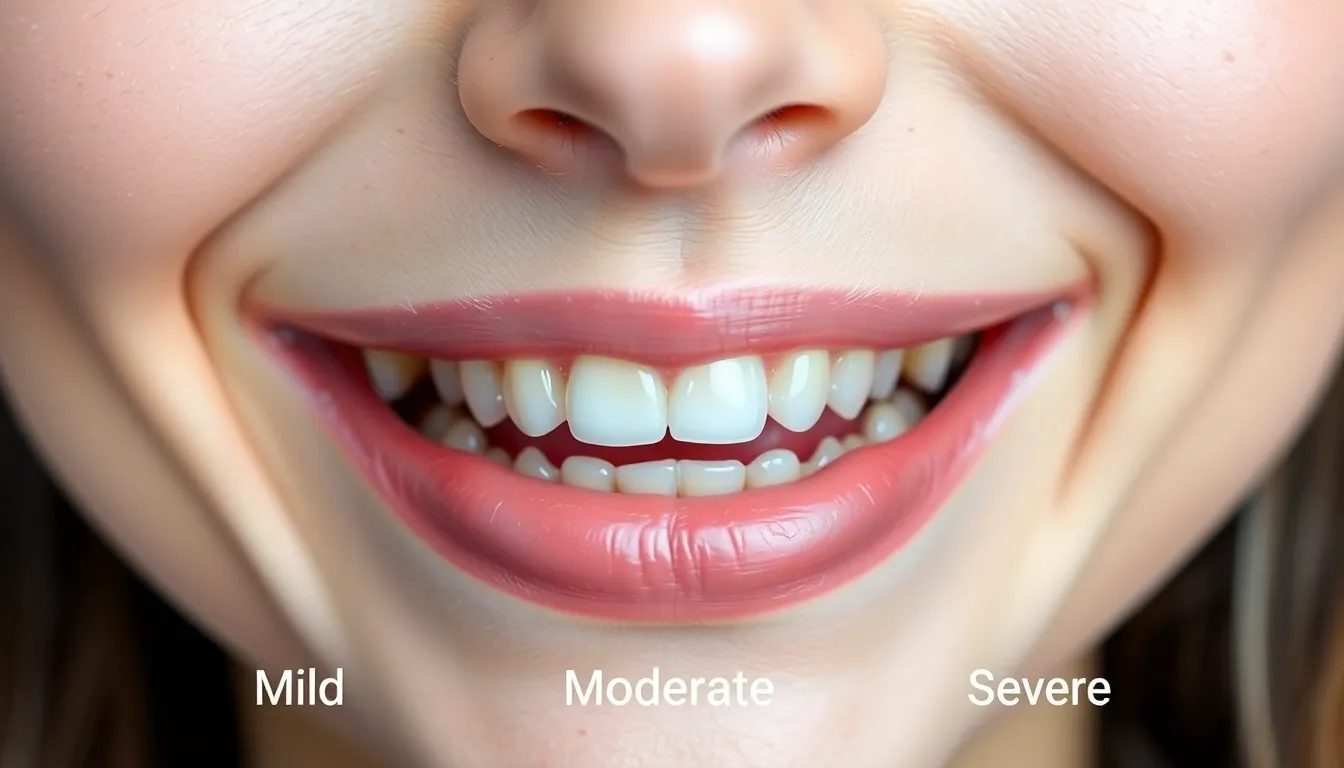
Overbites manifest in varying degrees of severity, each with distinct visual characteristics and potential impacts on oral function. Understanding these different levels helps in recognizing your exact condition and determining appropriate treatment options.
Mild Overbite Appearance
Mild overbites feature a slight overlap where upper front teeth extend over lower teeth by approximately 1-2 millimeters or cover 20-40% vertically. This minimal overlap represents a normal bite for many people and rarely causes functional problems. Your teeth still align properly during chewing, and speech remains unaffected. Most dentists consider this level of overbite aesthetically acceptable and functionally sound, requiring no intervention unless it causes discomfort.
“Many patients are surprised when I tell them their mild overbite is completely normal,” shares Dr. Todd B. Harris. “Just last month, a patient named Michael came in concerned about his ‘overbite problem’ after seeing photos of himself smiling. After examination, I explained that his 2mm overlap was within normal parameters and required no correction.”
Moderate Overbite Appearance
Moderate overbites create a more noticeable overlap exceeding 3mm or covering more than 40% of lower teeth vertically. Your upper front teeth appear prominently, sometimes creating what’s commonly called a “buck teeth” appearance. Chewing efficiency decreases with this level of misalignment, potentially causing jaw discomfort during meals. The aesthetic impact becomes more evident in your smile, affecting facial profile and sometimes leading to self-consciousness about your appearance.
Lisa, a 34-year-old patient with a moderate overbite, described her experience: “I always knew something was off with my bite because my upper teeth stuck out noticeably. Photos always made me self-conscious until I finally sought treatment. Understanding that my 4mm overbite was causing both my aesthetic concerns and occasional jaw pain was eye-opening.”
Severe Overbite Appearance
Severe overbites present as extensive or complete coverage of lower front teeth by upper teeth, creating what dentists call a “deep bite.” Your lower teeth might even contact the roof of your mouth in extreme cases, causing tissue damage and discomfort. This pronounced misalignment creates a dramatically receded chin appearance and significantly affects facial proportions. Functional problems accompany severe overbites, including difficulty biting food properly, accelerated tooth wear, persistent jaw pain, and even speech impediments in some cases.
The visual indicators of severe overbites include:
- Complete or near-complete hiding of lower front teeth when biting
- Potential indentations in the palate from lower teeth contact
- Noticeable jaw misalignment affecting overall facial structure
- Exaggerated vertical overlap creating an imbalanced facial profile
How Overbites Affect Facial Structure

Overbites significantly influence your facial appearance beyond just teeth alignment. The vertical overlap of upper teeth over lower teeth creates distinct changes to both your jaw profile and overall smile aesthetics.
Changes to Jaw Profile
An overbite alters the alignment and positioning of your jaws, often giving your lower jaw a recessed appearance. This misalignment makes your lower jaw look smaller or set back compared to your upper jaw, changing your natural jawline and facial profile. Many patients don’t realize how their facial structure is affected until they see before-and-after photos of overbite correction. The abnormal bite places strain on your temporomandibular joints (TMJ) over time, potentially causing discomfort or functional problems when chewing or speaking. Your chin position appears less prominent with a severe overbite, creating an imbalance in facial proportions that can affect your overall appearance.
Impact on Smile Aesthetics
An excessive overbite typically creates a “gummy” smile where your upper teeth cover too much of your lower teeth when smiling. The upper teeth protrusion affects the balance and harmony of your smile, making it look less natural or attractive. Dr. Todd B. Harris often points out that “patients with important overbites frequently hide their smiles in photos or cover their mouths when laughing due to self-consciousness about their appearance.” Severe overbites lead to excessive wear on teeth and uneven tooth display, impacting your overall smile aesthetics and oral health. Your lip position changes with an overbite, as your upper lip may appear more prominent while your lower lip curves inward to accommodate the protruding upper teeth. The vertical overlap can create an illusion of shorter lower facial height, affecting the overall balance of facial features from profile view.
Overbite vs. Other Dental Misalignments

Dental misalignments come in various forms, each affecting your bite and smile in different ways. Understanding these distinctions helps identify your exact condition and explore appropriate treatment options.
How Overbites Differ From Underbites
Overbites and underbites represent opposite dental alignment issues. An overbite occurs when your upper front teeth vertically overlap the lower teeth excessively, typically beyond the normal 1-3 millimeters (20-40%) overlap. Many patients with overbites notice their upper teeth covering a important portion of their lower teeth when closing their mouth. The appearance often gives a more prominent upper jaw look.
Underbites present the reverse scenario – your lower front teeth extend past the upper front teeth, creating a protruding lower jaw appearance. This condition causes a distinctive facial profile where the chin appears more prominent than the upper part of the face.
Dr. Todd B. Harris often tells patients, “Understanding whether you have an overbite or underbite significantly impacts your treatment approach. I recently treated a patient who believed she had an underbite for years, but after examination, we discovered she actually had a severe crossbite combined with a slight overbite. This completely changed our treatment strategy.”
Distinguishing Overbites From Crossbites
Overbites strictly involve vertical misalignment where your upper teeth overlap lower teeth excessively from top to bottom. The key characteristic remains the vertical nature of this dental condition.
Crossbites differ fundamentally as they involve horizontal misalignment issues. Your upper teeth fit inside your lower teeth horizontally, either at the front or sides of your mouth. This creates uneven biting surfaces and asymmetrical jaw movements during chewing.
The distinction between these conditions matters tremendously for proper diagnosis and treatment planning. Each misalignment requires different orthodontic approaches customized to the exact type of bite issue.
| Condition | Description | Visual Appearance |
|---|---|---|
| Overbite | Upper front teeth overlap excessively over lower | Upper teeth cover a large portion of lower teeth vertically |
| Underbite | Lower front teeth protrude beyond upper teeth | Lower jaw appears more prominent |
| Crossbite | Upper teeth bite inside lower teeth horizontally | Misaligned bite with uneven side/bite contact |
Treatment Options That Change Overbite Appearance

Correcting an overbite transforms both dental function and facial aesthetics through various treatment approaches. Your treatment options range from non-surgical orthodontic answers to more advanced surgical interventions depending on the severity of your condition.
Braces and Clear Aligners
Traditional braces and clear aligners effectively reposition teeth to correct mild to moderate overbites. Metal braces use brackets and wires to apply consistent pressure that gradually shifts teeth into proper alignment, reducing the excessive vertical overlap between upper and lower teeth. Clear aligners like Invisalign offer a more discreet alternative, using a series of custom-made transparent trays that move teeth incrementally over time. Treatment typically lasts 18-24 months for comprehensive cases, with noticeable improvements often visible within the first 6 months. Many patients report that beyond aesthetic improvements, they experience reduced jaw pain and better chewing function after treatment.
Dr. Todd B. Harris notes, “I’ve seen remarkable transformations in patients with overbites using modern aligner technology. The psychological impact is often as important as the physical changes—patients who spent years hiding their smiles suddenly can’t stop smiling.”
Surgical Corrections for Severe Cases
Orthognathic surgery becomes necessary for severe overbites caused by skeletal misalignments rather than just dental positioning issues. This surgical approach involves repositioning the upper or lower jawbone to create proper alignment and eliminate the excessive overlap. Surgical correction typically requires a combined approach—orthodontic treatment with braces before surgery to align the teeth, followed by the surgical procedure, and then additional orthodontic refinement afterward. Recovery from jaw surgery takes approximately 6-12 weeks, with final results fully visible after several months once swelling completely subsides.
Conclusion
Recognizing what an overbite looks like is your first step toward better oral health and facial aesthetics. From the subtle vertical overlap of mild cases to the pronounced protrusion of severe conditions these dental misalignments affect both function and appearance.
Whether you’re dealing with a vertical overbite that hides your lower teeth or a horizontal overjet creating that “buck teeth” appearance treatment options exist for every severity level. Modern orthodontics offers answers from clear aligners to traditional braces with surgical interventions available for more complex cases.
Don’t let an untreated overbite impact your confidence or oral health. With proper identification and professional guidance you can achieve proper alignment improved facial harmony and a smile you’ll be proud to show off.
Frequently Asked Questions
What is an overbite?
An overbite is a dental condition where the upper front teeth vertically overlap the lower front teeth by more than the normal 2-3 millimeters. It’s classified as a type of malocclusion (improper bite alignment) and is one of the most common orthodontic issues worldwide, affecting approximately 70% of children in the United States.
How can I tell if I have an overbite?
You can identify an overbite by looking at your teeth in a mirror. If your upper front teeth significantly overlap your lower teeth when you bite down, you likely have an overbite. The severity ranges from subtle to pronounced cases. For a proper diagnosis, consult with a dental professional who can evaluate the extent of your condition.
What causes an overbite?
Overbites are primarily caused by genetics and jaw structure. Inherited traits can affect jaw development and tooth positioning. Other contributing factors include childhood habits like prolonged thumb-sucking, pacifier use, or bottle feeding beyond the recommended age, which can apply pressure to developing teeth and jaws, influencing their growth pattern.
What’s the difference between an overbite and an overjet?
An overbite refers to the vertical overlap of upper teeth over lower teeth, while an overjet (sometimes called a horizontal overbite) refers to the horizontal protrusion of upper teeth beyond the lower teeth. Overjets create what people commonly call “buck teeth” and can create an “open bite” condition where the mouth cannot fully close.
Are there different types of overbites?
Yes, overbites can be classified as vertical (where lower teeth are partially or completely hidden) or horizontal (overjets, where upper teeth protrude forward). They also vary in severity: mild (1-2mm overlap requiring no treatment), moderate (3+mm causing aesthetic concerns), and severe (“deep bites” causing significant functional issues).
How does an overbite affect facial appearance?
An overbite can significantly alter facial structure by changing jaw alignment, often giving the lower jaw a recessed appearance. This affects the natural jawline and profile. Severe overbites can create a “gummy” smile and disrupt facial proportions. Many patients don’t realize these changes until seeing before-and-after correction photos.
What’s the difference between an overbite and an underbite?
An overbite occurs when upper front teeth excessively overlap lower teeth, while an underbite is the opposite – lower front teeth protrude beyond the upper teeth, creating a prominent lower jaw appearance. They require different treatment approaches and have distinct effects on facial appearance and dental function.
Can clear aligners fix an overbite?
Yes, clear aligners can effectively treat mild to moderate overbites. They work by gradually repositioning teeth into proper alignment. However, severe overbites, especially those caused by skeletal misalignments, may require traditional braces or surgical intervention. A consultation with an orthodontist will determine the best treatment option for your specific case.
How long does overbite correction take?
Typical overbite correction with braces or clear aligners takes 18-24 months, depending on severity. Non-surgical treatments require consistent wear and follow-up appointments. Surgical correction for severe cases involves a recovery period of 6-12 weeks, with final results visible after several months of healing and adjustment.
What problems can an untreated overbite cause?
Untreated overbites, especially severe ones, can lead to numerous complications including speech difficulties, increased risk of dental trauma, temporomandibular joint (TMJ) disorders, jaw pain, difficulty chewing, premature wear of tooth enamel, and self-consciousness about appearance. Early intervention can prevent these issues from developing.


